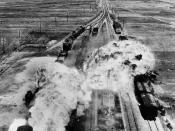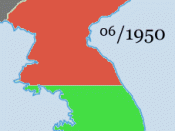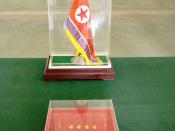A Capitalist society and a Communist society are two very different ways to govern a country. The first allows citizens and members of the public to own their own property, earn their own income, start their own private business, etc. Whilst the latter is the complete opposite of the first, the government owns everything and distributes payment, housing, food, etc, to all members of the community. In theory a communist society is an egalitarian society, where everyone receives the same food rations, lives in similar housing, earns the same income, etc. In reality, the communist project was a complete failure, since the people had no incentive to work knowing that they would receive the same payment anyway, products became scarce and shoddily made. The government became thirsty for power and didn't allow a change of government, in short democracy and freedom were overruled by this new regime. "All animals are equal, but some animals are more equal than others" George Orwell.
Not long after the end of World War Two, Korea was divided into two zones of occupation at the 38th Parallel. The southern zone was controlled by the American forces; the northern zone was controlled by the Soviet Union. The UN decided to establish two separate nations - the Republic of South Korea and the Democratic People's Republic of North Korea, since the Soviet Union would not agree to rejoin Korea.
When North Korean forces invaded South Korea, on the 25 June 1950, the Korean war officially began. The United Nations decided to send a force to defend South Korea, composed of contingents from 15 nations including Australia, Britain, United States, Greece, Colombia, New Zealand, The Philippines, Canada, Turkey, France, The Netherlands, South Africa and Luxembourg, and medical units from Denmark, India, Italy, Norway and Sweden.
Australia became involved in the Korean war because many Australians felt that Australia's safety was not secure from the communist opposition if it was not stopped in Korea. Australia was in danger because of its small army. The Australian Government's decision to enter the Korean war was fully supported by the major Opposition party, the Labor Party.
"We, as you know, in Australia are not rich in manpower. We feel that our people when they go to war are first class fighters.But in my talks with your leaders here it has been completely agreed that the time factor is so important in Korea. That a comparatively small force speedily prepared and dispatched is better than a larger force postponed for many months." Prime Minister Menzies.
Australian troops took part in two major battles in 1951. Chinese forces attacked the Kapyong valley on the evening of 22 April, forcing South Korean and New Zealand troops into retreat; other UN troops, including Australians, were ordered to stop the attack. Their positions were overrun, after one night of battling, the Australians recaptured their positions and stalled the Chinese advance, having only 32 men dead and a total of 53 wounded. The 3 RAR was awarded a US Presidential Citation, for their involvement.
The second major battle for the Australians was Operation Commando, an attack against a Chinese-held salient in a bend of the Imjin, a river running north-south that crosses the 38th parallel just above Seoul. The Commonwealth Division, including the Australians, had two key objectives: Hills 355 and 317. The attack began on 3 October, and five days later the Chinese withdrew. 20 Australians were killed and 83 lay wounded.
As the war settled into stalemate it was obvious that a truce was the only possible solution, however the military still put pressure on the communist force. As the fighting continued UN combatants grew less enthusiastic and some countries were eager to withdraw their troops from Korea. Australia, on the other hand, increased its commitment, and on 1 June 1952, the government sent a second battalion, 1 RAR, which joined the Commonwealth Division. The battalion remained in Korea for twelve months, leaving in March 1953 and replaced by 2 RAR in April.
UN and North Korean leaderships signed an agreement on 27 July 1953. This agreement theoretically brought the war to an end, but a state of suspended hostilities continued to exist between North and South Korea for many years. In the three years of fighting 1,263 men of the Commonwealth forces were killed and a further 4,817 were wounded, while the US lost 33,000 men. Australian casualties numbered more than 1,500. Almost half a million South Koreans died as a result of the war, and an unknown number of North Koreans and Chinese.
Bibliographyhttp://www.awm.gov.auhttp://www.australianhistory.org/korean-war.phphttp://www.australia.gov.au/Australia_at_Warhttp://www.anzacday.org.au/history/korea/koreamain.html


